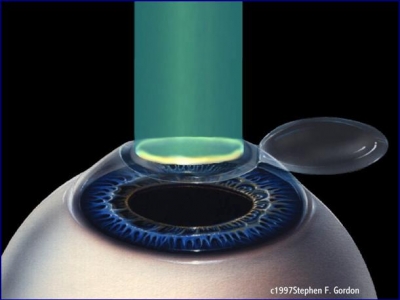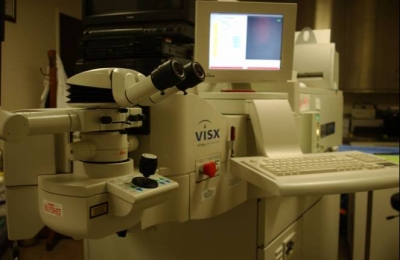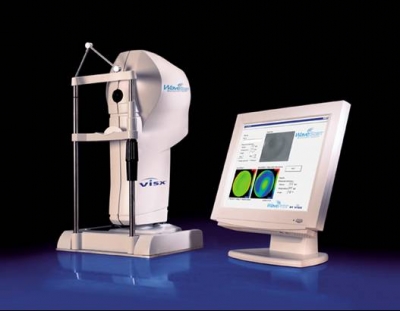By Jeffrey A. Rendall, Images Courtesy of Eye Doctors of Washington
|
|
BETHESDA, MD – Here’s a truism -- If you can’t see, you can’t play… at least when it comes to the game of golf.
Occasionally we’ll learn of a rare exception, about a blind golfer who’s overcome his physical challenge to enjoy the sport he loves. Much more common are the everyday tales of woe from nearsighted players who wear glasses or contacts – which, like in all aspects of life, constitutes a necessary evil and valuable piece of equipment in their own way.
Then there are the success stories of professional Tour athletes who’ve approached their sight problems with the same technological curiosity they’ve devoted to developing the best golf clubs and balls for their own personal specifications. They’ve taken the plunge, so to speak, as they’ve assessed the potential pitfalls in trying a ‘cutting edge’ medical procedure, and because of the advancements in the field of ophthalmology, can now see perfectly without glasses or contacts.
The names Tiger Woods, Fred Funk and Tom Kite come to mind immediately, but there are more. They’ve all had LASIK surgery, and they’re all better off for it.
In Tiger Woods’ case, he’d experienced problems for years with his contacts – drying out and having sand or other irritants blow into his eyes, which only made it worse. Others found wearing contacts more than a mere nuisance – because of their own situations, they couldn’t use them at all.
 |
| Thomas E. Clinch, MD |
Anyone who’s worn corrective lenses for an appreciable amount of time (as I had) knows exactly what Woods, Funk, Kite and every other ‘career’ nearsighted person knows – glasses and contacts are a pain. Not being able to see is like enduring a blurry universe that never goes away – where you’ll need to grab for your glasses to see the clock at night. Then there are the embarrassing times, when you even fail to recognize the person next to you when swimming in the ocean. Face it, vision problems aren’t much fun.
Based on a personal referral, I took my nearsighted issues to one of the best surgeons in the industry, Dr. Thomas Clinch. I’d worn glasses/contacts for over 20 years, and couldn’t see much without them, scoring 20/400 or worse in both eyes. My uncorrected vision was so weak I couldn’t tell the difference between my two daughters from more than a few feet away.
Having read about LASIK for years, it was time to think about solving my vision problems, and Dr. Clinch’s name kept coming up in the ‘where to find the answer’ conversations.
Dr. Paul Kang has joined Dr. Clinch’s practice, and says good vision is a lifestyle issue that can easily be addressed. “Usually, people have LASIK because they’re tired of wearing glasses or contact lenses, but there are also a number of people who see it as essential in their professions, such as professional athletes, fighter pilots and policemen. These are folks who rely on vision to the utmost, and with the improvements in laser vision correction, it makes sense for them to get the procedure.”
From personal experience, contacts were always annoying. I’d tried the extended wear lenses, daily lenses and even disposables – always enjoying good vision, but also having to put up with the side effects of tired eyes and irritation. And forget it if I ever got something in my eyes. Contact lenses ruined many a day for me, and glasses weren’t a lot better.
For those long suffering eye problems, LASIK (which is short for Laser In Situ Keratomileusis) was developed. Briefly, the surgery consists of two parts, which Kang describes: “The common eye problems that most people have, are nearsightedness, farsightedness or having as astigmatism (defined as, a visual defect caused by the unequal curving of one or more of the refractive surfaces of the eye, usually the cornea). Basically, what that means is that light, when it enters the eye, is not focused directly onto the retina.”
Kang continues, “Think of the retina as the film inside of a camera. If the lens isn’t focusing properly, you’re capturing a distorted image on the film. So what we do is use a laser to reshape the cornea – essentially sculpting the cornea – so we can accurately bend light to focus directly on the back of the eye.”
 |
| Diagram of LASIK. You can see the flap is made. Then laser energy is used to sculpt the cornea. Finally, the flap is placed back down. |
That makes sense. To us non-medical folks, we’re just getting a better lens for our camera. And that’s kind of what it’s like, according to Kang. He says LASIK is a procedure by which they’re giving you the best possible prescription contacts for your eyes – but without having to pop them out, buy them again in two weeks, or treat them with enzyme cleaners.
LASIK’s a two-step process. “First you have to make a flap,” Kang explained, “and that provides access to the inside of the cornea. Then you use a laser to reshape the cornea. Finally, you put the flap back in place.”
It sounds simple enough. Sometime in the distant future, maybe we’ll be able to buy a kit to perform the surgery on ourselves in front of the bathroom mirror. Then again, I’m not sure we’d want it that way.
Although LASIK is one-two, it’s critical that you choose the right surgeon to perform it – because not everyone who directs the laser is created equal. The surgery’s come a long way from its early days, to the point where it’s nearly completely automated, but it certainly helps to have the proper experience behind the blade, so to speak.
And that’s why, after doing some research, I felt comfortable with Clinch’s practice.
“We use the newest technology available, called IntraLase, which is bladeless or ‘all laser’ LASIK. It used to be that we needed to use a blade to make the flap – and while a blade is very good and the risks are very small, there are some inaccuracies associated with it. The IntraLase machine is very new, and it uses a laser to make the flap for you – which eliminates some of the risks associated with an inherent, kind of mechanical process. Though the difference is only measured in sub-microns, it’s still much more accurate than using a blade,” Kang said.
 |
| Photo of the VISX star 4 Laser. The secret to great vision is inside. |
For the squeamish, the concept of a laser cutting your eye is a tiny bit more tolerable than picturing a sharp blade doing the same thing.
Two things kept me from getting the surgery sooner – the possible side-effects of the surgery, and of course, cost. Though I’d heard the accounts of all the famous people who’d had the procedure done, it was still terrifying to think about the far-fetched chance of losing my vision. That was one of the first ‘myths’ to be cleared up by the Clinch crew.
It turns out, if you’ve heard of anyone completely losing their sight from having had LASIK, it’s just an urban legend. “To my knowledge, no one’s ever gone completely blind from having the procedure,” Kang said. “But there are a few things to consider. First of all, contrary to some peoples’ perceptions, it’s not permanent. Second, there are some mild risks associated with it, such as glare and halos in about 5% of patients, and dry eyes in about 5% of patients.”
Even then, that’s usually correctible. Kang says his re-treatment rate is about 1-2% (and so is Dr. Clinch’s), which essentially means that 1-2% would need to go ‘under’ the laser for another session – and that typically only happens when a patient is extremely nearsighted to begin with.
So you won’t go blind. The absolute worst case scenario is that you’d need a cornea transplant, but that only happens in a microscopically small sample – one out of every 25,000 procedures performed. The rest of that 1-2% of patients that needs re-treatment or an enhancement can be corrected to their satisfaction, in nearly every case. In other words, LASIK is pretty darn safe.
To continue keeping the recidivism rate low, you’ll receive the most thorough eye exam of your life before you even undertake the procedure, because Kang says it’s important that you be a good candidate for it – and also because the information gathered dictates your treatment. If your eyes have changed recently, it’s probably not a good idea, and if you’re not in overall good health, that’s another case where you shouldn’t have LASIK.
If you do qualify, then they’ll get into the details. One of the reasons why LASIK is so accurate these days is because of something Clinch and Kang call ‘Custom’ LASIK.
 |
| Paul C. Kang, MD |
Once again, Kang helps us understand: “Nobody’s eye is exactly the same. It’s kind of like taking fifty men, all wearing size ten shoes – they can all comfortably wear the size, yet if you looked at every man’s feet individually, they’re all different. Similarly, you can have fifty people with the same eyeglass prescription, but if you look at their eyes under the microscope, nobody’s would be exactly the same. There’re always little bumps and things that are different.”
“With our computerized technology, called ‘Wave Front,’ you can map an individual’s cornea, and custom design their treatment. It’s like finding their own thumbprint and providing them with a procedure that will best help them achieve their goals. Oftentimes the vision they end up with is better than they had with glasses or contact lenses, because no prescription is as precise,” Kang added.
The proof’s in the pudding – I now test out at 20-15, which provides an enhanced ability to see my golf balls flying into the trees, farther down the extremities of the hole.
Regarding costs, the procedure isn’t inexpensive, and nearly all insurance plans won’t cover LASIK. Many people would argue the procedure is ‘essential,’ but the policy makers in the insurance industry don’t see it that way.
Kang says the cost isn’t likely to go down, and the insurance companies don’t appear to be changing their ways – but nonetheless, LASIK is worth the money. “People have to understand, the vast majority of the fee goes towards the technology – in order for us to maintain the lasers and keep them so well calibrated… well, it costs a lot.”
He continues, “The lasers are so precise that we have to maintain the conditions at a certain level, in terms of temperature and humidity. Then there’s our practice’s inclination towards always using the latest techniques and equipment.”
 |
| Photo of Wavescan: Used to generate the Customvue treatments. |
Again, Kang’s right about the ‘conditions.’ Wear a jacket into the ‘operating’ room, as it’s pretty cool in there. I was lucky I had the procedure done in July, and it actually felt good to be in that room.
Dr. Clinch’s fee includes the entire process, from initial consultation to the procedure, to the post-op visits, of which there are several (and if you need an enhancement, there’s a 10 year guarantee). Be careful when looking at some of these low ‘per eye’ ads, as they probably don’t add in some of the little ‘extras.’ When everything’s totaled out, Dr. Clinch’s group is very competitive – and his experience is included (Dr. Kang’s as well).
Both Clinch and Kang are fellowship trained, specifically in cornea and refractive surgery. To earn the certification in cornea and refractive surgery, you spend an extra year of training (in addition to medical school and four years of residency to become an ophthalmologist) – not only in LASIK, but in LASIK complications. Not all of those performing LASIK have this kind of background (in fact, you can become certified after a weekend course), and it can very well make a difference. Why take a chance?
Clinch and Kang also have academic appointments at Georgetown University – they’re teaching this procedure to the next generation, and they also have access to all the latest ‘stuff.’ It’s that little bit of extra reassurance that you’re getting the best.
One final bit of ‘truth’ in the realm of LASIK myths – sometimes you’ll hear the procedure is completely painless. Well, it’s not. During the surgery itself, there’s some discomfort with the opening and closing of the eye flap. But then the adventure begins afterwards, with the post-op recovery.
It feels like you’ve had sand poured in your eyes… a bucket load of it, at that. From what I’ve heard, reactions vary from person to person, as far as the degree of ‘pain’ you’ll experience, but for me, it was a significant amount. Ouch! But then again, my eyes have always been very sensitive – hence, my desire to get rid of contacts.
The bright side is the pain and discomfort is gone by the next day, and you can sleep off most of the difficult hours. The post-op recovery period will last months (not a whole lot of inconvenience, but you can’t rub your eyes!), but it doesn’t ‘hurt’ anymore after the first few hours.
 |
| The IntraLase process -- how the flap is made. |
And you’ll see great. Waking up the morning after the surgery, I couldn’t believe what the world looked like after enduring decades of the contacts/glasses routine. I sometimes look at my old frames, thinking ‘I don’t remember what it was like to have to wear these things’ -- and I just gave away my last bottles of contacts solution.
LASIK is as good as advertised – it’s good for the golf course, but it’s also good for driving, outdoors activities… even household chores and yard work. And you’ll ‘see’ your spouse in a whole new way as well. It’s a world of change, and not a bad one to take a gander at, either.
Acknowledgements – Many thanks to Dr. Clinch and Dr. Kang for their expertise and a job well done. Thanks also to Dr. Melissa Barbor and the rest of Dr. Clinch’s staff for their care and conversation through the months of LASIK post-op. It was fun, and well worth it!
Details:
Eye Doctors of
Cornea and Refractive Surgery
Dr. Thomas E. Clinch
Dr. Paul C. Kang
Website: http://www.drclinch.com/
Phone: (301) 215-7100; Toll Free: 1-866-578-2020
Note: There’s also an office in downtown
Process: If you’re thinking about having LASIK – or if you’re merely curious, you can call and schedule a complimentary examination. It’s quick (and painless!), where you’ll receive a screening check to see if you’re a candidate for LASIK.
If you qualify and would like to have the procedure, then you’ll go in for the more thorough set of tests, where they’ll ‘map’ your eye for the surgery.
If you’ve got questions, I’d highly recommend going over the website, or better yet, calling the office.
| Related Links | Comments on this article? | |
|
Maryland National Golf Club Hollow Creek Golf Club Rocky Gap Resort PB Dye Golf Club in Ijamsville Whiskey Creek Golf Club |
E-mail Jeff Rendall, Editor: jrendall@golftheunitedstates.com |












